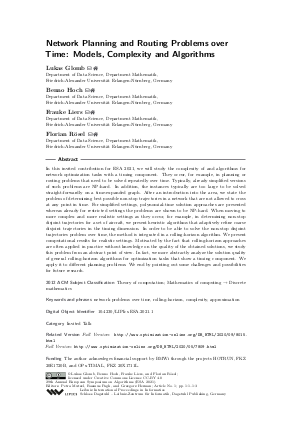Network Planning and Routing Problems over Time: Models, Complexity and Algorithms (Invited Talk)
Authors Lukas Glomb, Benno Hoch, Frauke Liers, Florian Rösel
-
Part of:
Volume:
29th Annual European Symposium on Algorithms (ESA 2021)
Part of: Series: Leibniz International Proceedings in Informatics (LIPIcs)
Part of: Conference: European Symposium on Algorithms (ESA) - License:
 Creative Commons Attribution 4.0 International license
Creative Commons Attribution 4.0 International license
- Publication Date: 2021-08-31
File

PDF
LIPIcs.ESA.2021.1.pdf
- Filesize: 367 kB
- 3 pages
Document Identifiers
Related Versions
Subject Classification
ACM Subject Classification
- Theory of computation
- Mathematics of computing → Discrete mathematics
Keywords
- network problems over time
- rolling-horizon
- complexity
- approximation
Metrics
- Access Statistics
-
Total Accesses (updated on a weekly basis)
0PDF Downloads0Metadata Views
Abstract
In this invited contribution for ESA 2021, we will study the complexity of and algorithms for network optimization tasks with a timing component. They occur, for example, in planning or routing problems that need to be solved repeatedly over time. Typically, already simplified versions of such problems are NP-hard. In addition, the instances typically are too large to be solved straight-forwardly on a time-expanded graph. After an introduction into the area, we state the problem of determining best possible non-stop trajectories in a network that are not allowed to cross at any point in time. For simplified settings, polynomial-time solution approaches are presented whereas already for restricted settings the problems are shown to be NP-hard. When moving to more complex and more realistic settings as they occur, for example, in determining non-stop disjoint trajectories for a set of aircraft, we present heuristic algorithms that adaptively refine coarse disjoint trajectories in the timing dimension. In order to be able to solve the non-stop disjoint trajectories problem over time, the method is integrated in a rolling-horizon algorithm. We present computational results for realistic settings. Motivated by the fact that rolling-horizon approaches are often applied in practice without knowledge on the quality of the obtained solutions, we study this problem from an abstract point of view. In fact, we more abstractly analyze the solution quality of general rolling-horizon algorithms for optimization tasks that show a timing component. We apply it to different planning problems. We end by pointing out some challenges and possibilities for future research.
Cite As Get BibTex
Lukas Glomb, Benno Hoch, Frauke Liers, and Florian Rösel. Network Planning and Routing Problems over Time: Models, Complexity and Algorithms (Invited Talk). In 29th Annual European Symposium on Algorithms (ESA 2021). Leibniz International Proceedings in Informatics (LIPIcs), Volume 204, pp. 1:1-1:3, Schloss Dagstuhl – Leibniz-Zentrum für Informatik (2021)
https://doi.org/10.4230/LIPIcs.ESA.2021.1
BibTex
@InProceedings{glomb_et_al:LIPIcs.ESA.2021.1,
author = {Glomb, Lukas and Hoch, Benno and Liers, Frauke and R\"{o}sel, Florian},
title = {{Network Planning and Routing Problems over Time: Models, Complexity and Algorithms}},
booktitle = {29th Annual European Symposium on Algorithms (ESA 2021)},
pages = {1:1--1:3},
series = {Leibniz International Proceedings in Informatics (LIPIcs)},
ISBN = {978-3-95977-204-4},
ISSN = {1868-8969},
year = {2021},
volume = {204},
editor = {Mutzel, Petra and Pagh, Rasmus and Herman, Grzegorz},
publisher = {Schloss Dagstuhl -- Leibniz-Zentrum f{\"u}r Informatik},
address = {Dagstuhl, Germany},
URL = {https://drops.dagstuhl.de/entities/document/10.4230/LIPIcs.ESA.2021.1},
URN = {urn:nbn:de:0030-drops-145822},
doi = {10.4230/LIPIcs.ESA.2021.1},
annote = {Keywords: network problems over time, rolling-horizon, complexity, approximation}
}
Author Details
- Department of Data Science, Department Mathematik, Friedrich-Alexander Universität Erlangen-Nürnberg, Germany
- Department of Data Science, Department Mathematik, Friedrich-Alexander Universität Erlangen-Nürnberg, Germany
- Department of Data Science, Department Mathematik, Friedrich-Alexander Universität Erlangen-Nürnberg, Germany
Funding
The author acknowleges financial support by BMWi through the projects HOTRUN, FKZ 20E1720B, and OPs-TIMAL, FKZ 20X1711L.
References
-
Bernardetta Addis, Giuliana Carello, Andrea Grosso, and Elena Tànfani. Operating room scheduling and rescheduling: a rolling horizon approach. Flexible Services and Manufacturing Journal, 28(1-2):206-232, 2016.

-
James C Bean and Robert L Smith. Conditions for the existence of planning horizons. Mathematics of Operations Research, 9(3):391-401, 1984.

- Lukas Glomb, Frauke Liers, and Florian Rösel. A rolling-horizon approach for multi-period optimization. European Journal of Operational Research, 2021. URL: https://doi.org/10.1016/j.ejor.2021.07.043.
-
Benedikt Grüter, Matthias Bittner, Matthias Rieck, Johannes Diepolder, and Florian Holzapfel. Optimal sequencing in atm combining genetic algorithms and gradient based methods to a bilevel approach. In ICAS 30th International Congress of the International Council of the Aeronautical Sciences, 2016.

-
Benno Hoch, Frauke Liers, Sarah Neumann, and Francisco Javier Zaragoza Martınez. The non-stop disjoint trajectories problem, 2020.

-
Mohammad Mohammadi, SMT Fatemi Ghomi, Behrooz Karimi, and S Ali Torabi. Rolling-horizon and fix-and-relax heuristics for the multi-product multi-level capacitated lotsizing problem with sequence-dependent setups. Journal of Intelligent Manufacturing, 21(4):501-510, 2010.

-
Arthur Richards and Jonathan P How. Aircraft trajectory planning with collision avoidance using mixed integer linear programming. In American Control Conference, 2002. Proceedings of the 2002, volume 3, pages 1936-1941. IEEE, 2002.

-
Johannes Schmidt and Armin Fügenschuh. A two-time-level model for mission and flight planning of an inhomogeneous fleet of unmanned aerial vehicles. Technical report, BTU Cottbus, 2021.

-
Suresh Sethi and Gerhard Sorger. A theory of rolling horizon decision making. Annals of Operations Research, 29(1):387-415, 1991.

